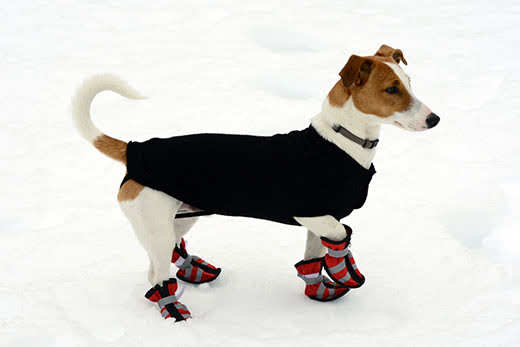
Hypothermia in dogs: symptoms and treatment
With the onset of winter, remember to keep your pet warm and dry. Cold and wet conditions can be dangerous for unprotected paws, ears and tails. By the way, frostbite in dogs is one of the most common winter injuries faced by veterinarians.
It’s difficult to say exactly how cold a temperature needs to be or how long a pet needs to stay out in the cold to be at risk of frostbite. However, water, high winds, and touching metal can increase the chance of frostbite in dogs.
Contents
Clinical signs of frostbite in dogs
According to the Merck Veterinary Manual, frostbite usually occurs on areas of the body with thinner coats and less insulation. The parts of the body most exposed to wind and moisture, including the tips of the ears, nose, paws, and tail, are also at increased risk of frostbite. Therefore, it is important to protect them from the winter cold properly.
The appearance of a frostbitten area in a dog can vary, depending on the severity of the injury and the amount of time that has elapsed since exposure.
 With shallow frostbite, the skin in the affected area becomes paler than the surrounding area. At the same time, peeling of the skin, hair loss, blisters or redness can be observed on it. The affected area may also be numb or painful. Deeper frostbite leads to hardening of the affected area of the skin. It may be cool to the touch, even if the dog is already warm. The skin that is most affected tends to darken. Such an affected area may become wet, bleed, and yellow-green discharge may appear on it. Over time, severe damage can lead to tissue death and rejection.
With shallow frostbite, the skin in the affected area becomes paler than the surrounding area. At the same time, peeling of the skin, hair loss, blisters or redness can be observed on it. The affected area may also be numb or painful. Deeper frostbite leads to hardening of the affected area of the skin. It may be cool to the touch, even if the dog is already warm. The skin that is most affected tends to darken. Such an affected area may become wet, bleed, and yellow-green discharge may appear on it. Over time, severe damage can lead to tissue death and rejection.
Frostbite from exposure to low temperatures can occur in any dog. However, pets that have not acclimatized to winter weather, and dogs with sparse coats, are at higher risk. Puppies and older dogs are also more prone to frostbite because their thermoregulatory processes are generally less stable. In addition, dogs with poor circulation, such as those with diabetes, are more likely to suffer from frostbite.
How Veterinarians Diagnose and Treat Frostbite in Dogs
Frostbite on the paws of dogs has classic external signs. As a rule, it is easy to diagnose if it is known that the four-legged friend was exposed to low temperatures.
If detected early, treatment includes mild rewarming and supportive care. If the pet has a low body temperature in general, the treatment plan should take this into account.
Frostbite cannot be treated at home. If your pet shows signs of frostbite, you should immediately go to a specialist. Self-medication can do more harm than good if you start warming the skin too quickly.
Unfortunately, severe frostbite may require surgical removal of the affected areas. The veterinarian will likely delay surgery on the damaged tissue until the exact size of the affected area is known. Since tissue damage does not appear immediately, you will have to endure several days.
Frostbite does not spread to other tissues after injury. In order for all the damage to become clearly visible, it will take quite a bit of time.
How to avoid frostbite on your dog’s paws
In winter, paw pads can dry out and crack. A veterinarian can recommend a good moisturizer for them. However, it is important not to use your hand moisturizer for this purpose, as this can soften the pads and cause injury.
 Many of the chemicals in de-icing agents used to keep roads and sidewalks safe are quite corrosive to dog paws. To avoid wounds and blisters, before walking, the pet’s paws can be smeared with a thin layer of petroleum jelly or wax. Winter boots are another way to protect your dog’s paws from the harsh winter conditions. Most four-legged friends quickly get used to shoes, although at first the poor fellow will probably look very funny.
Many of the chemicals in de-icing agents used to keep roads and sidewalks safe are quite corrosive to dog paws. To avoid wounds and blisters, before walking, the pet’s paws can be smeared with a thin layer of petroleum jelly or wax. Winter boots are another way to protect your dog’s paws from the harsh winter conditions. Most four-legged friends quickly get used to shoes, although at first the poor fellow will probably look very funny.
If the dog’s paws get wet in sub-zero temperatures, ice can form on the fur around the paw pads. To prevent this undesirable phenomenon, comb the hair on the paws, especially between the toes, and trim it evenly to the level of the paw pads. This simple procedure can be carried out by a groomer: he will probably make such a haircut more accurately.
Regular clipping of nails is a necessary habit that should be acquired from the first days of a puppy’s life. If you don’t cut your dog’s nails short, they may catch on something or they may break off. In winter, under the influence of low temperatures, the claws become more brittle and easier to damage. Your veterinarian will tell you more about how to properly trim your dog’s nails.
For extreme cold weather, check out winter pet options and winter safety tips. With a little preparation, you can safely take your dog on winter walks without worrying about the risk of frostbite.





